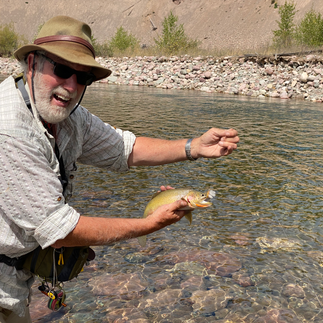Fishing in the Big Wild
- Mark Wilbert

- Sep 6, 2023
- 3 min read

McGinn and I have recently returned from our great adventure for 2023: a fishing trip deep into the Bob Marshall Wilderness in western Montana. It was, nominally, a fishing trip, but experiencing “big wild” was equally important. “The Bob”, as folks call it, is the largest of three contiguous wilderness areas, totaling about 1.5 million acres: the second largest wilderness block in the lower 48 states. I say we were “deep” into the wilderness because the 28-mile horse ride into the outfitter’s camp put us approximately halfway across the breadth of the Bob and a little south of the north-south midpoint. But to say it, or even to see it on a map, doesn’t nearly convey the feeling of giant space and remoteness. For me that came only after several days of moving about. Each day we’d walk or ride to some stretch of the South Fork Flathead River to fish to our heart’s content. Each trip took us two to eight miles from camp. I began to realize that even the longest trek took us to what seemed just another place along the river. We crossed no passes; climbed no peaks; saw no change in forests on the hillsides. The countryside looked basically the same as back at camp. It began to sink in just how significant a journey it would have to be to give me the sense of change that I get from a short day-hike in the Cascades. THERE was the “big wild” feeling I had hoped to find.
As for the fishing: pretty darn good. As you’d expect for the latter half of August, the rivers were low and cool (not frigid), making wet wading easy and comfortable. These are riffle-and-run waters characteristic of moderate gradient mountain streams.

Fish were plentiful and eagerly rose to dry flies—hoppers, stoneflies, and mayflies. We had equally good luck on nymphs when we tried them. Based on the number of shucks we saw dried on rocks in and along the South Fork, there must be one heck of a stonefly hatch earlier in the year.

The fish were all native cutthroat, most ranging from eight to twelve inches, but over the course of our six days we each caught a fair number of fish in the 15” to 17” range. They’re lively and strong fish, though not terribly acrobatic. Fun to catch. And did I say plentiful? McGinn assures me there were 20-40 fish to hand each day. I’m sure there were an equal number of takes missed (speaking for myself, of course).

The bull trout were staging to spawn, so we had a couple of exciting attacks as they swooped in on a smaller fish one of us was fighting. I tried a small white Sculpzilla in a couple of the deeper holes without drawing one of the big boys in. My guess is that it wasn’t large enough to interest them. After all, it was our 8-inch fish they were chasing.
For six days we had near-perfect dry weather: sunny and warm early on, followed by several days of overcast with a few sun breaks. It wasn’t until our last full day of fishing that we got serious rain. It came down steadily throughout the day and came down in buckets for about ten minutes as an active afternoon cell passed over. We got soaking wet, but the fish didn’t mind. They continued to rise to any fly we through to them. No time to miss a meal when winter is coming, I guess.

As we sloshed our way back into camp that afternoon, we were greeted by a warm wood stove burning in our tent: a literal warm welcome from the camp staff. This was just the final bit of outstanding service that Outfitter, Mark Cheff, and five young wranglers/cooks/bottle-washers provided. It started with our realization that McGinn and I would be the only guests—something that must have strained the outfitter’s pocketbook given his per/day expenses. We were grateful for this gesture. And throughout our stay, Ree, Landon, Luke, Tino, and Marty helped make us thoroughly comfortable. They prepared meals (wonderful western comfort food), filled us with stories, pointed us at the best fishing spots, wrangled horses as we needed them, and guided us through the beautiful countryside. These are exceptional young people: confident in themselves and eager to lend a hand with whatever task they find needs doing. They’re quick to laugh and good listeners—even to two old guys like McGinn and me. Mark and his crew made the trip memorable as much as the fishing and scenery did.
If this kind of trip interests you, you won’t find better than Mark Cheff and 406 Wilderness Outfitters (406 Wilderness Outfitters - Bob Marshall Wilderness Hunts, Hikes, Packing & Fishing), family owned and operated for three generations.



















































Comments